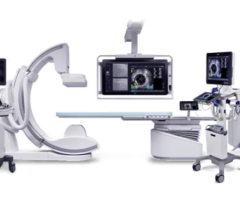
May 20, 2016 — Using optimal frequency domain imaging (OFDI) to guide percutaneous coronary intervention (PCI) with second-generation drug eluting stents (DES) achieves equivalent clinical and angiographic outcomes to intravascular ultrasound (IVUS)-guided PCI at 12 months. This conclusion was part of results of the OPINION study, reported in a late-breaker session at EuroPCR 2016.
IVUS is an imaging modality used to assess lesion morphology during PCI, and several studies have reported that IVUS guidance in PCI might be helpful to improve outcomes. OFDI is the most recently developed optical coherence tomography (OCT) technology that uses light rather than ultrasound to give high-resolution imaging.
"OPINION is the first study to compare clinical outcomes with OFDI and IVUS to assess lesion morphology during PCI with second-generation drug-eluting stents," explained study author Takashi Kubo, from Wakayama University, Wakayama, Japan.
The OPINION study researchers randomized 800 patients (mean age 68 years) scheduled for PCI using DES to either OFDI-guided PCI or IVUS-guided PCI at 42 centers in Japan. Patients underwent PCI using drug-eluting stents with resorbable polymer in de novo native coronary artery lesions. They were followed-up with angiography at eight months and the primary endpoint was target vessel failure assessing during clinical follow-up at 12 months.
Results of the non-inferiority study reported at EuroPCR 2016 showed a similarly low rate of target vessel revascularization — a composite of cardiac death, target vessel-related MI and clinically driven target vessel revascularization — at 12 months in patients undergoing OFDI-guided PCI (5.2 percent) as in those randomized to IVUS-guided PCI (4.9 percent).
"The clinical outcome in both OCT-guided PCI and IVUS-guided PCI was excellent," reported Kubo. He suggested the study results contribute to defining the clinical value of OCT guidance in PCI. "Our results might influence the next ESC guidelines, which currently give a class IIb recommendation for OCT. OCT use during PCI should have a class IIa recommendation," he said.
Commenting on the findings, Takashi Akasaka, professor of medicine at Wakayama Medical University, Wakayama, Japan, said, "There has previously been no direct comparative data for OCT/OFDI-guided PCI and IVUS-guided PCI. The OPINION study succeeded in demonstrating that OCT-guided PCI resulted in equivalent clinical and angiographic outcomes at 12 months to IVUS-guided PCI."
Akasaka considers the clinical outcome with both imaging strategies was very good, with a low rate of target vessel revascularization, "thus, the OPINION study may contribute to define the clinical value of the OCT guidance in PCI." He agreed that the findings mean that OCT/OFDI-guided PCI should be given a class IIa recommendation.
For more information: www.europcr.com


 December 20, 2023
December 20, 2023 








